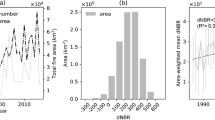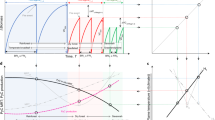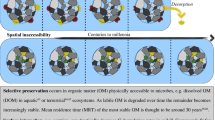Abstract
Boreal forest fires emit large amounts of carbon into the atmosphere primarily through the combustion of soil organic matter1,2,3. During each fire, a portion of this soil beneath the burned layer can escape combustion, leading to a net accumulation of carbon in forests over multiple fire events4. Climate warming and drying has led to more severe and frequent forest fires5,6,7, which threaten to shift the carbon balance of the boreal ecosystem from net accumulation to net loss1, resulting in a positive climate feedback8. This feedback will occur if organic-soil carbon that escaped burning in previous fires, termed ‘legacy carbon’, combusts. Here we use soil radiocarbon dating to quantitatively assess legacy carbon loss in the 2014 wildfires in the Northwest Territories of Canada2. We found no evidence for the combustion of legacy carbon in forests that were older than the historic fire-return interval of northwestern boreal forests9. In forests that were in dry landscapes and less than 60 years old at the time of the fire, legacy carbon that had escaped burning in the previous fire cycle was combusted. We estimate that 0.34 million hectares of young forests (<60 years) that burned in the 2014 fires could have experienced legacy carbon combustion. This implies a shift to a domain of carbon cycling in which these forests become a net source—instead of a sink—of carbon to the atmosphere over consecutive fires. As boreal wildfires continue to increase in size, frequency and intensity7, the area of young forests that experience legacy carbon combustion will probably increase and have a key role in shifting the boreal carbon balance.
This is a preview of subscription content, access via your institution
Access options
Access Nature and 54 other Nature Portfolio journals
Get Nature+, our best-value online-access subscription
$29.99 / 30 days
cancel any time
Subscribe to this journal
Receive 51 print issues and online access
$199.00 per year
only $3.90 per issue
Buy this article
- Purchase on Springer Link
- Instant access to full article PDF
Prices may be subject to local taxes which are calculated during checkout



Similar content being viewed by others
Code availability
The R code for emissions is archived with the original publication2. The R code used for all analyses in this study is available from the corresponding author upon request.
References
Bond-Lamberty, B., Peckham, S. D., Ahl, D. E. & Gower, S. T. Fire as the dominant driver of central Canadian boreal forest carbon balance. Nature 450, 89–92 (2007).
Walker, X. J. et al. Cross-scale controls on carbon emissions from boreal forest megafires. Glob. Change Biol. 24, 4251–4265 (2018).
Amiro, B. D. et al. Direct carbon emissions from Canadian forest fires, 1959–1999. Can. J. For. Res. 31, 512–525 (2001).
Chapin, F. S. et al. Reconciling carbon-cycle concepts, terminology, and methods. Ecosystems 9, 1041–1050 (2006).
Kasischke, E. S. & Turetsky, M. R. Recent changes in the fire regime across the North American boreal region—spatial and temporal patterns of burning across Canada and Alaska. Geophys. Res. Lett. 33, 09703 (2006).
Balshi, M. S. et al. Assessing the response of area burned to changing climate in western boreal North America using a Multivariate Adaptive Regression Splines (MARS) approach. Glob. Change Biol. 15, 578–600 (2009).
de Groot, W. J., Flannigan, M. D. & Cantin, A. S. Climate change impacts on future boreal fire regimes. For. Ecol. Manage. 294, 35–44 (2013).
Li, F., Lawrence, D. M. & Bond-Lamberty, B. Impact of fire on global land surface air temperature and energy budget for the 20th century due to changes within ecosystems. Environ. Res. Lett. 12, 044014 (2017); corrigendum 12, 069501 (2017).
Johnstone, J. F. et al. Fire, climate change, and forest resilience in interior Alaska. Can. J. For. Res. 40, 1302–1312 (2010).
Kelly, R. et al. Recent burning of boreal forests exceeds fire regime limits of the past 10,000 years. Proc. Natl Acad. Sci. USA 110, 13055–13060 (2013).
Johnson, E. A. Fire and Vegetation Dynamics (Cambridge Univ. Press, 1992).
Little, D., Farrell, E. & Collins, J. Land-use legacies and soil development in semi-natural ecosystems in the marginal uplands of Ireland. Catena 30, 83–98 (1997).
Rogers, B. M., Soja, A. J., Goulden, M. L. & Randerson, J. T. Influence of tree species on continental differences in boreal fires and climate feedbacks. Nat. Geosci. 8, 228–234 (2015).
Turetsky, M. R. et al. Recent acceleration of biomass burning and carbon losses in Alaskan forests and peatlands. Nat. Geosci. 4, 27–31 (2011).
Boby, L. A., Schuur, E. A., Mack, M. C., Verbyla, D. & Johnstone, J. F. Quantifying fire severity, carbon, and nitrogen emissions in Alaska’s boreal forest. Ecol. Appl. 20, 1633–1647 (2010).
Lorenz, K. & Lal, R. in Carbon Sequestration in Forest Ecosystems (eds Lorenz, K. & Lal, R.) 159–205 (Springer, 2010).
Harden, J. W. et al. The role of fire in the boreal carbon budget. Glob. Change Biol. 6, 174–184 (2000).
Hoy, E. E., Turetsky, M. R. & Kasischke, E. S. More frequent burning increases vulnerability of Alaskan boreal black spruce forests. Environ. Res. Lett. 11, 095001 (2016).
Walker, X. J. et al. Soil organic layer combustion in boreal black spruce and jack pine stands of the Northwest Territories, Canada. Int. J. Wildland Fire 27, 125–134 (2018).
Johnstone, J. F., Hollingsworth, T. N. & Chapin, F. S. A Key for Predicting Postfire Successional Trajectories in Black Spruce Stands of Interior Alaska. General Technical Report PNW-GTR-767 (US Department of Agriculture, 2008).
Mack, M. C. et al. Carbon loss from an unprecedented Arctic tundra wildfire. Nature 475, 489–492 (2011).
Levin, I. & Hesshaimer, V. Radiocarbon – a unique tracer of global carbon cycle dynamics. Radiocarbon 42, 69–80 (2000).
Hayes, D. J. et al. Is the northern high-latitude land-based CO2 sink weakening? Glob. Biogeochem. Cycles 25, GB3018 (2011).
van der Werf, G. R. et al. Global fire emissions estimates during 1997–2016. Earth Syst. Sci. Data 9, 697–720 (2017).
Pellegrini, A. F. A. et al. Fire frequency drives decadal changes in soil carbon and nitrogen and ecosystem productivity. Nature 553, 194–198 (2018).
Schuur, E. A. G. et al. Climate change and the permafrost carbon feedback. Nature 520, 171–179 (2015).
Minayeva, T. Yu. et al. Carbon accumulation in soils of forest and bog ecosystems of southern Valdai in the Holocene. Biol. Bull. 35, 524–532 (2008).
Young, A. M., Higuera, P. E., Duffy, P. A. & Hu, F. S. Climatic thresholds shape northern high-latitude fire regimes and imply vulnerability to future climate change. Ecography 40, 606–617 (2017).
Yue, X. et al. Impact of 2050 climate change on North American wildfire: consequences for ozone air quality. Atmos. Chem. Phys. 15, 10033–10055 (2015).
Cook, E. R. & Kairiukstis, L. Methods of Dendrochronology: Applications in the Environmental Sciences (Springer Science and Business Media, 1990).
Trumbore, S. E. & Harden, J. W. Accumulation and turnover of carbon in organic and mineral soils of the BOREAS northern study area. J. Geophys. Res. Atmos. 102, 28817–28830 (1997).
Melvin, A. M. et al. Differences in ecosystem carbon distribution and nutrient cycling linked to forest tree species composition in a mid-successional boreal forest. Ecosystems 18, 1472–1488 (2015).
Trumbore, S. E. et al. in Radiocarbon and Climate Change: Mechanisms, Applications and Laboratory Techniques (eds Schuur, E. A. G. et al.) 279–315 (Springer, 2016).
Vogel, J. S., Southon, J. R. & Nelson, D. E. Catalyst and binder effects in the use of filamentous graphite for AMS. Nucl. Instrum. Methods Phys. Res. B 29, 50–56 (1987).
Schuur, E. A. G., Druffel, E. R. & Trumbore, S. E. Radiocarbon and Climate Change: Mechanisms, Applications and Laboratory Techniques (Springer, 2016).
de Groot, W. J. et al. Estimating direct carbon emissions from Canadian wildland fires. Int. J. Wildland Fire 16, 593–606 (2007).
Fraser, R. H., Li, Z. & Cihlar, J. Hotspot and NDVI differencing synergy (HANDS): a new technique for burned area mapping over boreal forest. Remote Sens. Environ. 74, 362–376 (2000).
Burton, P. J., Parisien, M.-A., Hicke, J. A., Hall, R. J. & Freeburn, J. T. Large fires as agents of ecological diversity in the North American boreal forest. Int. J. Wildland Fire 17, 754–767 (2008).
Parisien, M.-A. et al. Spatial patterns of forest fires in Canada, 1980–1999. Int. J. Wildland Fire 15, 361–374 (2006).
Stocks, B. J. et al. Large forest fires in Canada, 1959–1997. J. Geophys. Res. 107, 8149 (2002).
Walker, X. J. et al. ABoVE: wildfire carbon emissions and burned plot characteristics, NWT, CA, 2014–2016. ORNL DAAC https://doi.org/10.3334/ORNLDAAC/1561 (2018).
R Development Core Team. R: a language and environment for statistical computing (2018).
Heinze, G., Ploner, M., Dunkler, D. & Southworth, H. logistf: Firth’s bias-reduced logistic regression (2016).
Heinze, G. & Schemper, M. A solution to the problem of separation in logistic regression. Stat. Med. 21, 2409–2419 (2002).
Burnham, K. P. & Anderson, D. R. Model Selection and Multimodel Inference: A Practical Information-Theoretic Approach (Springer Science and Business Media, 2003).
Burnham, K. P., Anderson, D. R. & Huyvaert, K. P. AIC model selection and multimodel inference in behavioral ecology: some background, observations, and comparisons. Behav. Ecol. Sociobiol. 65, 23–35 (2011).
Hosmer, D. W., Lemeshow, S. & Sturdivant, R. X. Applied Logistic Regression (John Wiley & Sons, 2013).
Walker, X. J. et al. ABoVE: characterization of carbon dynamics in burned forest plots, NWT, Canada, 2014. ORNL DAAC https://doi.org/10.3334/ORNLDAAC/1664 (2019).
Acknowledgements
This project was supported by funding awarded to M.C.M. from NSF DEB RAPID grant number 1542150, and from the NASA Arctic Boreal and Vulnerability Experiment (ABoVE) Legacy Carbon grant NNX15AT71A; by NSERC Discovery Grants to J.F.J. and M.R.T.; by Government of the Northwest Territories Cumulative Impacts Monitoring Program Funding project number 170 to J.L.B.; by an NSERC-PDF to N.J.D.; and by Polar Knowledge Canada’s Northern Science Training Program funding awarded to Canadian field assistants. Logistical and financial support was provided through the Government of the Northwest Territories–Wilfrid Laurier University Partnership Agreement.
Author information
Authors and Affiliations
Contributions
M.C.M. conceived the study with help from S.G., J.F.J., E.A.G.S. and X.J.W. M.C.M., X.J.W., J.F.J., M.R.T., J.L.B., S.G.C. and N.J.D. designed the field sampling. X.J.W. and N.J.D. collected the field data. X.J.W. and C.E. completed the laboratory work with technical support from M.C.M. and E.A.G.S. X.J.W. analysed the data with help from M.C.M. and E.A.G.S. B.M.R. and S.P. provided the data and wrote the Methods section ‘Estimation of young burned area’. X.J.W. wrote the manuscript and all co-authors edited the manuscript.
Corresponding author
Ethics declarations
Competing interests
The authors declare no competing interests.
Additional information
Publisher’s note: Springer Nature remains neutral with regard to jurisdictional claims in published maps and institutional affiliations.
Peer review information Nature thanks Mary Edwards and the other, anonymous, reviewer(s) for their contribution to the peer review of this work.
Extended data figures and tables
Extended Data Fig. 1 Area burned in the 2014 wildfires in the Northwest Territories of Canada that was considered as young burned (younger than 60 years at the time of fire).
a, b, Percentage (a) and cumulative percentage (b) of area burned in the 2014 wildfires, expressed in years since the fire and year of burn. In a, the dashed line represents the best fit between the observed values in the fire databases and the solid line represents the linear extrapolation to 1954. Grey shading indicates the standard error of the observed values and red shading indicates the predicted standard error (y = 0.01430x + 0.01097; R2 = 0.09; P < 0.05).
Rights and permissions
About this article
Cite this article
Walker, X.J., Baltzer, J.L., Cumming, S.G. et al. Increasing wildfires threaten historic carbon sink of boreal forest soils. Nature 572, 520–523 (2019). https://doi.org/10.1038/s41586-019-1474-y
Received:
Accepted:
Published:
Issue Date:
DOI: https://doi.org/10.1038/s41586-019-1474-y
This article is cited by
-
Simulation of the Ecosystem Productivity Responses to Aerosol Diffuse Radiation Fertilization Effects over the Pan-Arctic during 2001–19
Advances in Atmospheric Sciences (2024)
-
Assessing changes in global fire regimes
Fire Ecology (2024)
-
Contribution of remote sensing to wildfire trend and dynamic analysis in two of Ghana’s ecological zones: Guinea-savanna and Forest-savanna mosaic
Fire Ecology (2023)
-
Post-fire forest recovery at high latitudes: tree regeneration dominated by fire-adapted, early-seral species increases with latitude
Annals of Forest Science (2023)
-
Soil carbon storage capacity of drylands under altered fire regimes
Nature Climate Change (2023)
Comments
By submitting a comment you agree to abide by our Terms and Community Guidelines. If you find something abusive or that does not comply with our terms or guidelines please flag it as inappropriate.



